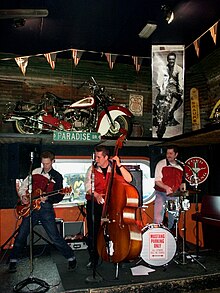
Back روكابيلي Arabic Рокабили Bulgarian Rockabilly Catalan Rockabilly Czech Rockabilly CSB Rockabilly Danish Rockabilly German Rockabilly Greek Rokabilo Esperanto Rockabilly Spanish
| Rockabilly | |
|---|---|
 Classic instruments associated with rockabilly are a hollow-body guitar, an upright bass, and a pared-down drum kit | |
| Stylistic origins | |
| Cultural origins | Early to mid-1950s, Southern United States |
| Derivative forms | Garage rock |
| Fusion genres | |
| Other topics | |
Rockabilly is one of the earliest styles of rock and roll music. It dates back to the early 1950s in the United States, especially the South. As a genre, it blends the sound of Western musical styles such as country with that of rhythm and blues,[1][2] leading to what is considered "classic" rock and roll.[3] Some have also described it as a blend of bluegrass with rock and roll.[4] The term "rockabilly" itself is a portmanteau of "rock" (from "rock 'n' roll") and "hillbilly", the latter a reference to the country music (often called "hillbilly music" in the 1940s and 1950s) that contributed strongly to the style. Other important influences on rockabilly include western swing, boogie-woogie, jump blues, and electric blues.[5]
Defining features of the rockabilly sound included strong rhythms, boogie woogie piano riffs, vocal twangs, doo-wop acapella singing, and common use of the tape echo;[6] and eventually came to incorporate different instruments and vocal harmonies.[2] Initially popularized by artists such as Carl Perkins, Elvis Presley, Johnny Burnette, Jerry Lee Lewis and others, the rockabilly style waned in the late 1950s; nonetheless, during the late 1970s and early 1980s, rockabilly enjoyed a revival. An interest in the genre endures even in the 21st century, often within musical subcultures. Rockabilly has spawned a variety of sub-styles and has influenced the development of other genres such as punk rock.[6]
- ^ "ROCKABILLY Definition". Shsu.edu. Retrieved August 22, 2015.
- ^ a b Craig Morrison (November 21, 2013). "rockabilly (music) - Encyclopædia Britannica". Britannica.com. Retrieved May 22, 2014.
- ^ "ROCKABILLY Definition". Shsu.edu. Retrieved May 22, 2014.
- ^ The American Heritage® Dictionary of the English Language, Fourth Edition copyright ©2000 by Houghton Mifflin Company. Updated in 2009. Published by Houghton Mifflin Company.
- ^ Cite error: The named reference
countrywas invoked but never defined (see the help page). - ^ a b "Fundamentals of Rockabilly". Guitar.com. Archived from the original on July 6, 2014. Retrieved May 22, 2014.